For
the greater part of the year, the San Francisco Bay Area
features sunny, but cool and dry climate. From May to November rains are particularly
unusual and outside of the watered areas in the local parks, mushrooms are
rare. All this changes with the onset of winter when the
Pacific Ocean unleashes its storms with a fury. Having gained moisture
over the vast expanse of the ocean these systems are wet and travel far. By the
time the TV News report on floods and deep snow in the rest of the country along
their path, we should head for the woodchip patches to see who has awakened
after the long dormant summer.
|
|
The
woodchip covered surfaces in the urbanized zones present a readily accessible
laboratory of fungal development. It is a great way to initiate beginners without
the need to travel too far. While not the preferred ground for mycophiles,
those who enjoy the mere sight of fungi in great numbers, and like to learn
more about them find the woodchip patches most convenient.
The
broader Bay Area is a fairly large territory that features several unique
microclimates and habitats. This write-up addresses the rectangular area on
the map (marked with pink) where I do most of my woodchip exploration.
The
variety of park and garden mushrooms is great, including many ectomycorrhizal
species. Distinguishing which species prefer woodchips versus the surrounding
non-woodchip areas requires repeated observation and judgment. Here I have
included only the species that I have seen at least 3 times. Excluded are
common grass species, such as Conocybe
lactea, Panaeolus phoenisecii and
many others.
|
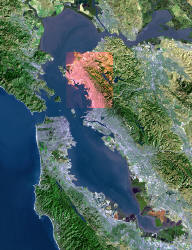
The San Francisco Bay Area |
|
In
general I am not equipped to always be able to identify the type of woodchip
material, but since I have personally observed how the park service tends to
mulch whatever is left from tree management, in many cases one can easily
surmise its origin. In general, the woodchips in the East Bay fall in the
following 3 groups of origin:
Monterey Cypress (Cupressus macrocarpa)
Blue Gum (Eucalyptus globulus)
Pines ("Monterey"
P. radiata, "Torrey" P. torreyana, "Aleppo" P.
halepensis, and various others)
The
Monterey Cypress is a California native tree that has spread outside of its
natural habitat into most parks. Other European Cypresses have also been widely
planted. The fast growing, Blue Gum tree
(Eucalyptus globulus) has become the
most abundant tree in the urbanized areas. It was introduced in the late 19-th
Century from Tasmania and has found the local conditions very favorable. On the
other hand, it is not favored by mycophiles, as it is not particularly friendly
to mushrooms, and even less so to mycorhizal species. The most common pines in
the local parks are Monterey Pine (Pinus
radiata) and Torrey Pine (Pinus
torreyana). Other Western pines are planted too, as well as many other
introduced pines, such as Aleppo Pine (Pinus
halepensis).
Following
are the most common woodchip species, ordered by frequency of encounter and
size of patches (subjectively).
|
|
Stropharia "riparia"
Commonly known as the "Highway Stropharia" --
this species is probably unnamed. S. percevalii looks very similar, but
has much larger spores. The original S. riparia that
A.H. Smith described from the
Pacific Northwest is significantly smaller in size although
that microscopically I have not been able to detect differences. This is the most abundant
species by far in this kind of habitat. In the woodchip
covered divider of a local highway, I have seen patches stretching for miles
during the rainy spells. Once finding myself overpowered
by an outburst of McIlvainian spirit I
sautéed a few caps and found it to be an excellent edible.
|
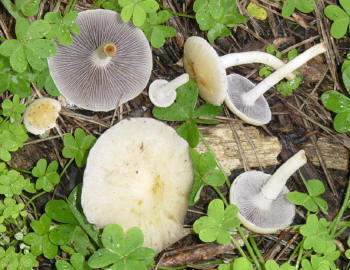
Stropharia riparia_small.JPG)
S. riparia & S. aurantiaca
|
|
Stropharia aurantiaca
This
mushroom of an unknown origin has become known worldwide. It is easily distinguished from a distance,
bragging powerfully contrasting, yet beautifully harmonized colors. Its
beauty can best be appreciated under gloomy skies on a rainy day.
|
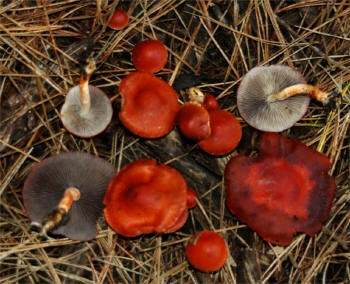
Stropharia aurantiaca_small1.JPG)
S. riparia & S. aurantiaca
|
|
Agrocybe praecox
This
is another "in your face" mushroom that pops up anywhere on or
close to woodchips. It also claims worldwide distribution. But unlike the
previous two species, I have seen it quite frequently outside of woodchip
areas -- clustered in leaf litter, on the side of roads, or in pure Oak
stands. Its cracked pileus is quite distinguishing in most cases, although
when young it can look very similar in stature to S. riparia.
|
_small.JPG) 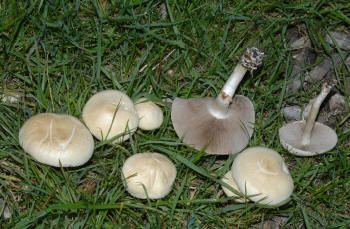
Agrocybe praecox
|
|
Stropharia ambigua
This
gorgeous native of the Pacific Northwest graces many quarters in its natural
habitat, but by far the most magnificent patches that I have seen locally
were on Eucalyptus mulch. Substantial in size and purportedly benign, it's strong earthy odor ("dry leaves" according
to Arora) makes it quite unappealing to be tried in the kitchen.
|
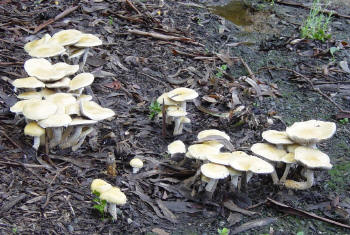 _small.JPG)
Stropharia ambigua
|
|
Tubaria furfuracea
This
quintessential little brown mushroom (LBM) would be perfectly ignorable if it
weren't for the immense troop numbers when it decides to fruit. Recently I
inspected several collections to determine whether they really represent 'furfuracea' and it turned out that
they do indeed
|
_small.JPG)
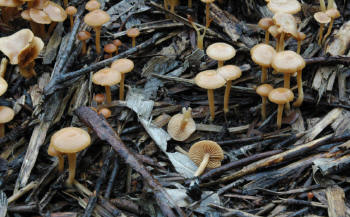
Tubaria furfuracea
|
|
Agrocybe putaminum |
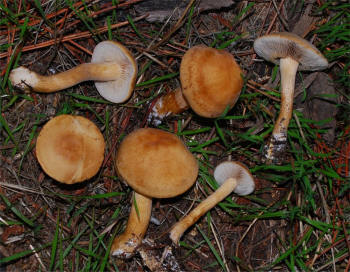
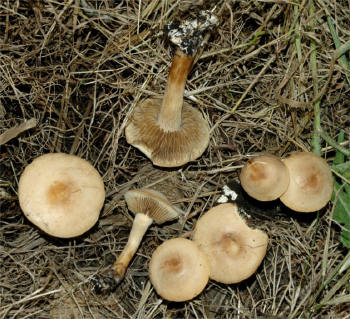 |
|
Gymnopus "stinkii"
This
commonly seen fetid species forms dense clusters on well rotted woody
material. Curiously, according to Prof. Desjardin it still remains formally
unpublished. It has a sister taxon from the Eastern NA that shares the same
faith. Macroscopically, it looks similar to Gymnopus brassicolens from
Europe.
|
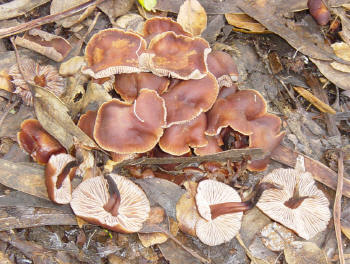
Gymnopus sp. (undescribed)
|
|
Pluteus cervinus
Woodchips
or not, wherever something is rotting, it seems that the Deer mushrooms has
found its home. P. cervinus is by far the most common
representative of the genus in the woodchip beds. I think I have seen P.
atromarginatus and probably others, but the taxonomy of this genus for
California hasn’t been fully developed yet and a dedicated local monograph is
not available. Therefore, I am shying away from doing the research to put
better names to the species that I encounter.
|
_small.JPG)
Pluteus cervinus
|
|
Hypholoma fasciculare
This
cosmopolitan fungi with a worldwide distribution is quite
common in nature near decaying wood, as well as being abundant on pine mulch.
It is readily distinguished by the greenish colors of its gills in maturity
as well as by its bitter taste. Unfortunately, its
sought after cousin, H. capnoides, is far rarer in my
experience.
|
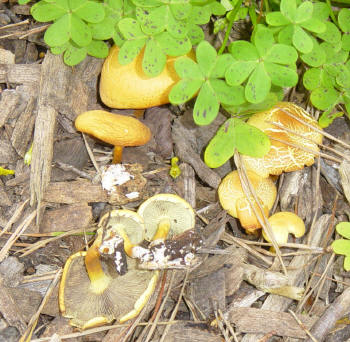 _small.JPG)
Hypholoma fasciculare
|
|
Peziza repanda
A
very common ascomycete on woodchips of all origins. It is a member of a
confusing group that requires microscopical analysis to be identified
precisely.
|
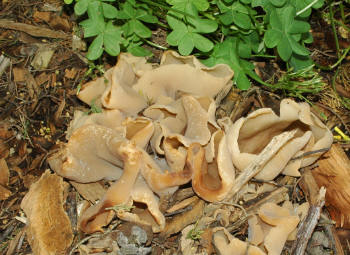 _small.JPG)
Peziza repanda
|
|
Gymnopilus sapineus
The
bright orange/yellow clusters of this mushroom can liven up the view on gray
days. As common as Gymnopilus spp. are in their
natural habitat in the early part of the mushroom season, in the local parks G.
sapineus comes later and after the extended rainy spells have soaked
the pine mulch quite well.
|
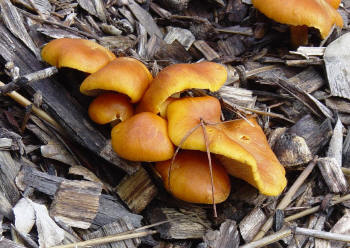 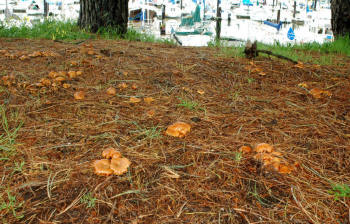
Gymnopilus sapineus (both pictures)
|
|
Volvariella speciosa
This
is the only species in this genus that is officially recognized from
California. An abundant species, it is as common to
find on woodchips as it is on lawns. V. speciosa is the only
mushroom I have seen fruiting consistently amidst the locally widespread
"Ice plant" (native of S. Africa).
|
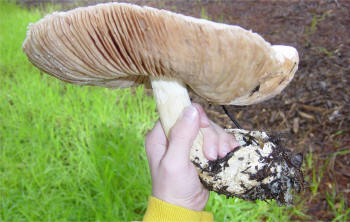
Volvariella speciosa
(can get quite large)
|
|
Clathrus ruber
This
is one of the most striking mushrooms. Its beauty is matched only by its
stinky odor. Tropical species by origin, it has been spreading rapidly
throughout the woodchip beds in the area. From published reports, it seems
that its expansionist march is not limited to California only.
|
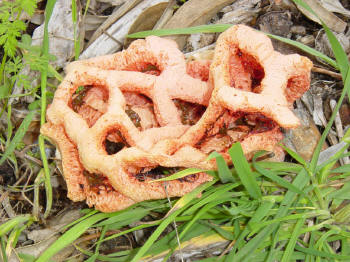
Clathrus ruber (gorgeous Stinkhorn)
|
|
Psathyrella candolleana
Known
as a typical park mushroom, I see extensive growth on woodchips that are in
an advanced stage of decay.
|
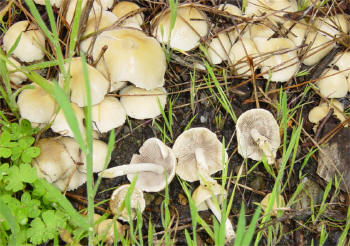
Psathyrella candolleana
|
|
Coprinus leiocephalus
This
fragile little inky cap is most likely to be mistaken for C. plicatilis,
which is a close relative. Early in the season, after the first heavy rains,
I've seen densely populated patches that amount to several hundred, even
thousands of fruitbodies.
|
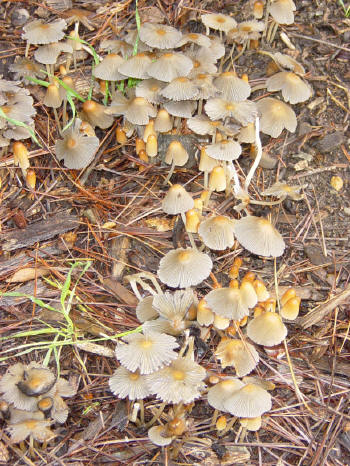 _small.JPG)
Coprinus leiocephalus
|
|
Psathyrella conopilus
Forming
beautiful troops in older woodchip patches mixed with grass, this frequent
and slender specimen can be identifies microscopically quite easily due its
pileus features – long setae reaching 200μ
in length. Supposedly they can be seen with a hand
lens, but my attempts were not entirely convincing.
|
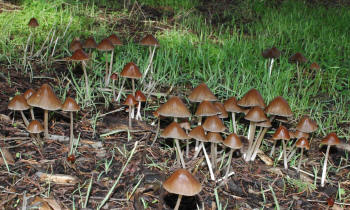
Psathyrella conopilus
|
|
Tapinella panuoides
(=Paxillus
panuoides)
I
have included this species here because two years ago it was quite frequent on
pine mulch. I am yet to see it this season (it has been dry overall).
|
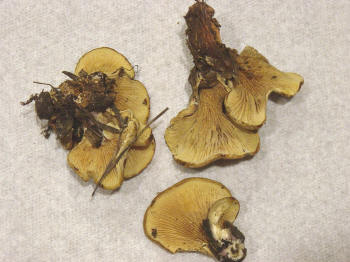
Tapinella panuoides
|
|
Lysurus mokusin
Occasionally,
I see Lysurus mokusin popping up later in the season, after the
first extended warm spells of the Spring.
|
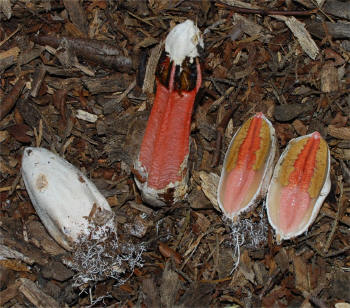
Lysurus mokusin
|
|
Chlorophyllum brunneum
(=Macrolepiota rachodes)
While
not strictly woodchip species, it bears mentioning that whenever Cypress mulch
is laid thick this species demonstrates an explosive growth, forming thick
clusters.
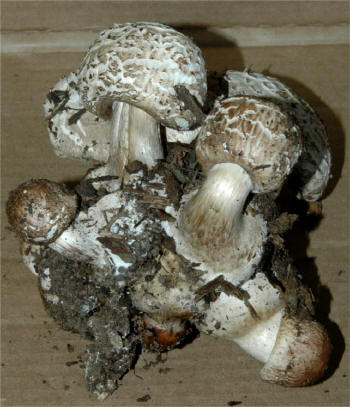
There
are a couple of areas in the East Bay where we regularly collect a few pounds
of shaggy parasols per visit. Best fruiting is after the first warming trend
of the Spring. Undercooked it can
cause a mild gastrointestinal upset (experienced by me). Otherwise it is a
splendid mushroom that can be used in various recipes.
|
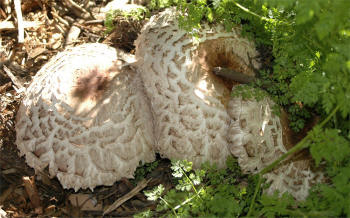 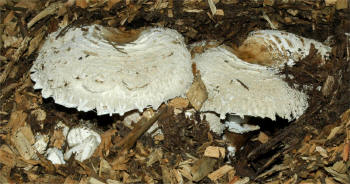 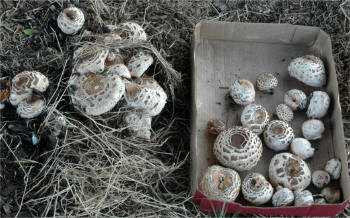
|